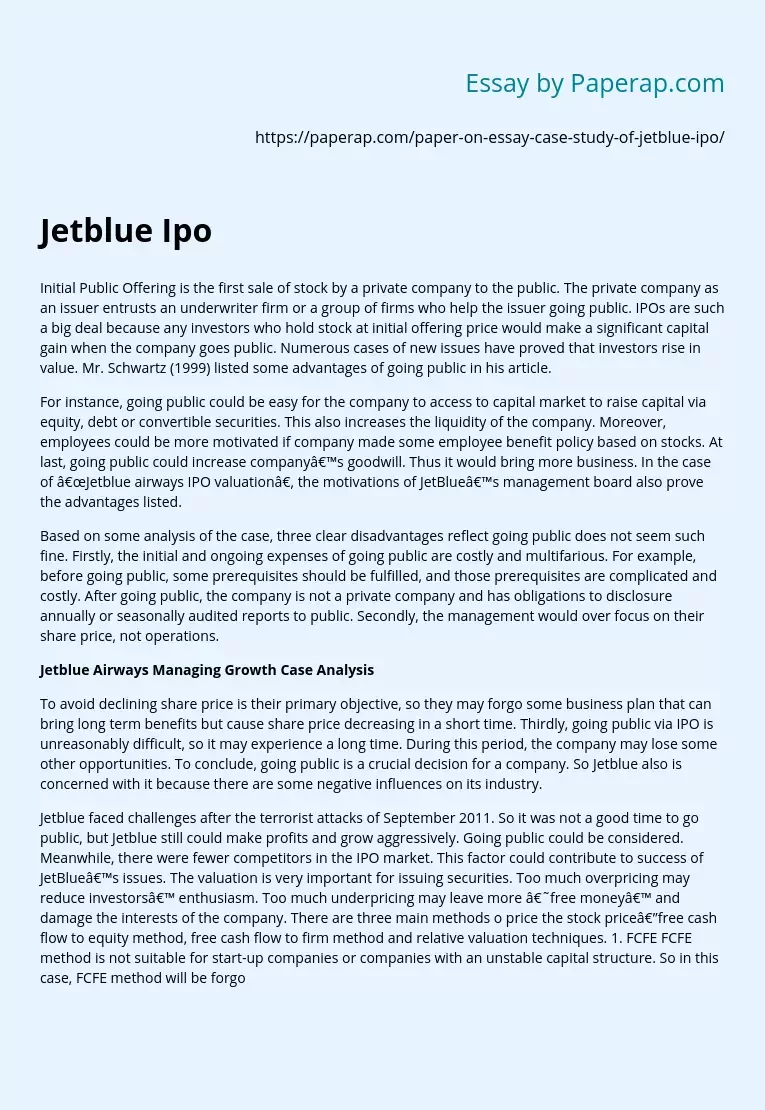IPO Basics: Selling Stock to the Public
Initial Public Offering is the first sale of stock by a private company to the public. The private company as an issuer entrusts an underwriter firm or a group of firms who help the issuer going public. IPOs are such a big deal because any investors who hold stock at initial offering price would make a significant capital gain when the company goes public. Numerous cases of new issues have proved that investors rise in value. Mr. Schwartz (1999) listed some advantages of going public in his article.
For instance, going public could be easy for the company to access to capital market to raise capital via equity, debt or convertible securities. This also increases the liquidity of the company. Moreover, employees could be more motivated if company made some employee benefit policy based on stocks. At last, going public could increase company’s goodwill. Thus it would bring more business. In the case of “Jetblue airways IPO valuation”, the motivations of JetBlue’s management board also prove the advantages listed.
Based on some analysis of the case, three clear disadvantages reflect going public does not seem such fine. Firstly, the initial and ongoing expenses of going public are costly and multifarious. For example, before going public, some prerequisites should be fulfilled, and those prerequisites are complicated and costly. After going public, the company is not a private company and has obligations to disclosure annually or seasonally audited reports to public. Secondly, the management would over focus on their share price, not operations.
Jetblue Airways Managing Growth Case Analysis
To avoid declining share price is their primary objective, so they may forgo some business plan that can bring long term benefits but cause share price decreasing in a short time. Thirdly, going public via IPO is unreasonably difficult, so it may experience a long time. During this period, the company may lose some other opportunities. To conclude, going public is a crucial decision for a company. So Jetblue also is concerned with it because there are some negative influences on its industry.
Jetblue faced challenges after the terrorist attacks of September 2011. So it was not a good time to go public, but Jetblue still could make profits and grow aggressively. Going public could be considered. Meanwhile, there were fewer competitors in the IPO market. This factor could contribute to success of JetBlue’s issues. The valuation is very important for issuing securities. Too much overpricing may reduce investors’ enthusiasm. Too much underpricing may leave more ‘free money’ and damage the interests of the company. There are three main methods o price the stock price—free cash flow to equity method, free cash flow to firm method and relative valuation techniques. 1. FCFE FCFE method is not suitable for start-up companies or companies with an unstable capital structure. So in this case, FCFE method will be forgone. 2. FCFF FCFF is preferable for a company with a history of leverage changes, as its growth rate will be more stable than FCFE growth rate, which means FCFF is useful for startup companies without a stable capital structure. While valuating IPO, there are some key assumptions: terminal growth rate is 4. %; after 2010, the FCFF will constantly grow at a speed of 4. 5%. So the terminal value is 4,819. 24million. Here we can set the WACC (9. 21%) as the discount rate to calculate NPV. Share price is estimated around $30. To conclude, all the calculations are based on the Exhibit 13. The forecast in the exhibit 13 is reasonable because all assumptions are based on reality. The aircraft has limited seats, so the output per aircraft is unchangeable. The only way to increase revenue is to increase the ticket price. So the growth rate is the inflation rate is reasonable.
Moreover, the length of forecast period is also reasonable. From 2009, the value of FCFF turns to be positive. 3. Relative valuation techniques. Relative valuation is used to complement DCF analysis. The key steps are to identify similar or comparable investments and recent market prices for each and to estimate the initial value of asset. The method of comparable involves using a price multiple to evaluate whether an asset is relatively fairly valued, relatively undervalued, or relatively overvalued in relation to a benchmark value of the multiple.
For this case of JetBlue, P/E multiple and EBIT multiple can be used as benchmarks to estimate the share price of JetBlue. P/E Multiple: In the Exhibit 3, net income in 2001 equaled to $38,537,000. So share price is $38,537,000*29. 12/40,600,000=$27. 6 EBIT Multiple: Business valuation= profits * EBIT multiple=38,537,000*20. 71=798,101,270 So share price= business valuation/ shares=$20 In summary, after those two valuations of the JetBlue’s IPO, we can recommend that the current price level ($26) is in a reasonable range.
IPO Basics: Selling Stock to the Public. (2019, Dec 05). Retrieved from https://paperap.com/paper-on-essay-case-study-of-jetblue-ipo/

